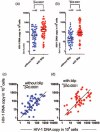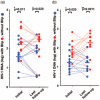HIV-1 viral blips are associated with repeated and increasingly high levels of cell-associated HIV-1 RNA transcriptional activity
- PMID: 34148986
- PMCID: PMC8505147
- DOI: 10.1097/QAD.0000000000003001
HIV-1 viral blips are associated with repeated and increasingly high levels of cell-associated HIV-1 RNA transcriptional activity
Abstract
Objective: Some HIV+ patients, virally suppressed on ART, show occasional 'blips' of detectable HIV-1 plasma RNA. We used a new highly sensitive assay of cell-associated HIV-1 RNA to measure transcriptional activity in PBMCs and production of infectious virus from the viral reservoir, in patients with and without 'blips'.
Design/methods: RNA and DNA extracted from cells in 6 ml of peripheral blood, from suppressed patients with one to two 'blip' episodes over the past 2 years of ART (n = 55), or no 'blips' (n = 52), were assayed for HIV-1 RNA transcripts and proviral DNA targeting the highly conserved 'R' region of the LTR. Follow-up samples were also collected. Purified CD4+ T cells were cultured with anti-CD3/CD28/CD2 T-cell activator to amplify transcription and measure replication competent virus.
Results: HIV-1 RNA transcripts ranged from 1.3 to 5415 copies/106 white blood cells. 'Blip' patients had significantly higher levels vs. without blips (median 192 vs. 49; P = 0.0007), which correlated with: higher levels of inducible transcripts after activation in vitro, sustained higher HIV-1 transcription levels in follow-up samples along with increasing HIV-1 DNA in some, and production of replication-competent HIV-1.
Conclusion: Viral 'blips' are significant reflecting higher transcriptional activity from the reservoir and contribute to the reservoir over time. This sensitive assay can be used in monitoring the size and activity of the HIV-1 reservoir and will be useful in HIV-1 cure strategies.
Copyright © 2021 The Author(s). Published by Wolters Kluwer Health, Inc.
Conflict of interest statement
K.S. receives research funds from Denka Co. Ltd. K.S. is the original inventor under WO2018/045425 (PTC/AU2017/050974) patent, titled ‘Methods of detecting Lentivirus’ of HIV-1 detection targeting ‘R’ region.
Figures
References
-
- Palella FJ, Jr, Delaney KM, Moorman AC, Loveless MO, Fuhrer J, Satten GA, et al. . Declining morbidity and mortality among patients with advanced human immunodeficiency virus infection. HIV Outpatient Study Investigators. N Engl J Med 1998; 338:853–860. - PubMed
-
- Teira R, Vidal F, Munoz-Sanchez P, Geijo P, Viciana P, Ribera E, et al. . VACH Study Group. Very low level viraemia and risk of virological failure in treated HIV-1-infected patients. HIV medicine 2017; 18:196–203. - PubMed
-
- den Oudsten M, van Kampen J, Rijnders B, van de Vijver D, van der Ende M. Is HIV-1 viraemia below 20 copies/mL in antiretroviral-treated patients associated with virologic outcome?. Infect Dis (Lond) 2019; 51:259–267. - PubMed
Publication types
MeSH terms
Substances
LinkOut - more resources
Full Text Sources
Medical
Research Materials
Miscellaneous




